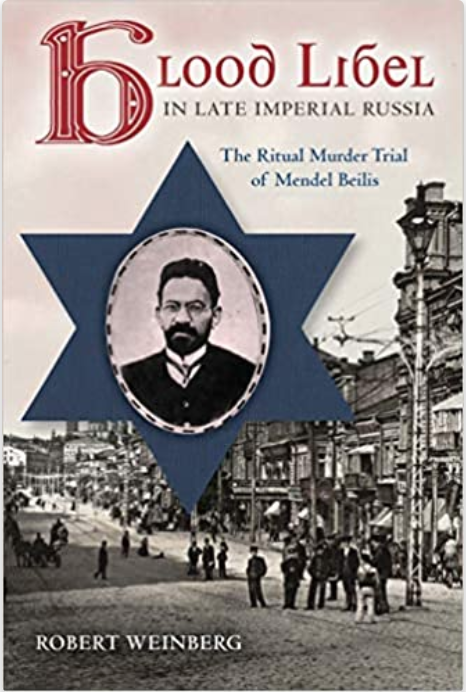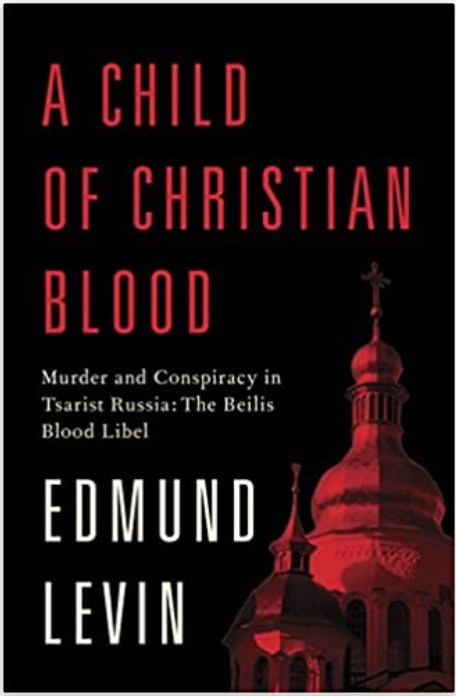
In 2014 there appeared two books, devoted to the so-called Beilis affair. One of the incentives for their appearance was the fact that 2013 marked the hundredth anniversary of the affair, which in fact took place in 1913 in Kiev, when the Jew Menahem Mendel Beilis was charged with the murder, which had actually happened two years earlier in 1911, of the Christian boy Andrei Iushchinskii for religious purposes – that is, in order to get his blood.
These two books consistently, although in different styles, relate the history of the Beilis affair. Most of the details related in these books are essentially the same: part of the law enforcement personnel felt that it was not a ritual murder and tried to resist the falsification of the case, and hence also the incrimination of Beilis, but the other side (especially assistant prosecutor Georgii Chaplinskii) together with local right-wingers, as well as with the support of some high-level officials (Minister of Justice Ivan Shcheglovitov), fabricated the case against Beilis. The absurdity of the situation was that Beilis was not a religious Jew, yet the indictment only implied religious reasons. Both authors believe that, most likely, the crime was committed by Vera Cheberiak together with her gang of thieves. Cheberiak in order to conceal the crime imitated a ritual murder, and later contributed to the incrimination of Beilis. In a very similar manner both authors evaluate the process, in which the prosecutors did not provide any solid evidence against Beilis, and their invited experts, for example the priest Justinas Pranaitis, during the trial appeared as totally incompetent. As well-known, the court acquitted Beilis, but acknowledged Iushchinskii's killing as a ritual murder and in doing so loosely confirmed the charges against the whole Jewish community.

The fact that these books have a lot of similarities should not surprise. Both were written basing upon works of same historians (especially of Hans Rogger, the favourite of the two authors) and on similar sources. Both use similar comparisons (for example, the notorious Dreyfus case in France). Both believe that the increase in blood libel cases detected in Central and Eastern Europe at the end of the nineteenth and the beginning of the twentieth centuries, was associated with the emergence of anti-Semitism (Levin, p. 306; Weinberg p. 7). Both Levin and Weinberg at the beginning of their books provide a list of the main characters, which in general is more typical to the theatrical genre, rather than academic literature. So, even though there are important differences (which we will discuss later) in these books, the overall picture of the Beilis affair is very similar.
This case was already well-known to researchers of the history of East European Jews1 and, moreover, remained for a long time in the cultural memory of East European Jews themselves. Yet, a detailed academic study was indeed missing. In a larger context, it must be said that the blood libel cases in the Russian Empire until now have gained far less attention2 than those in Prussia (German Empire) and Austria (Austrian-Hungarian Empire).3
The books discussed here, devoted to the Beilis affair, are important not only because they reconstruct in-details the course of this case, describe the attitudes and actions of various groups of society and the representatives of the authorities, but also for more general reasons. First of all, they are important for the scholarly debate about the relationship between the older hostility to the Jews (Jew-hatred) and modern forms of anti-Semitism; secondly, they are relevant in the context of the dispute of the Russian government’s role in organizing anti-Jewish pogroms or accusing Jews of using the blood of Christians.
In scholarly literature one can find those who strictly separate the old (religious) hostility to the Jews from the modern (secular) one; others do not see essential differences between intolerance to the Jews in the Middle Ages and modern times. The Beilis affair clearly shows that another interpretation is more accurate: that modern anti-Semitism, in fact, was different from the previous forms of hostility to the Jews (it became “scientific” – based on racial theory, it encouraged immediate political action, stressed very much the entrenchment of the Jews throughout the world and so on), but it also integrated older forms of Jew-hatred. The belief that Jews need Christian blood for religious or medical purposes, which was found not only in the nineteenth but also in subsequent centuries, is just good proof of such symbiosis. As Weinberg writes, “In fact, it is likely that both kinds of antisemitism influenced and even reinforced each other. Antisemitism was acquiring a modern complexion, but pre-modern prejudices sustained it” (p. 8).
For a long time the investigation of the history of Jews in the Russian Empire were influenced by the publications of the famous political activist and historian Simon Dubnov, according to which the life of the Jews in the Romanov Empire had been a permanent torment, and the imperial government from the partitions of Poland-Lithuania at the end of the eighteenth century consistently discriminated against the Jews. Even more so, the government organized pogroms against Jews and prepared processes, which accused the Jews of using the blood of Christians. The historiography of the last few decades rejected this interpretation. The works of Hans Rogger, Schlomo Lambroza, John D. Klier, Alexey Miller and others clearly showed that the discrimination of the Jews did not begin immediately after the first partition of Poland-Lithuania4, that the imperial government was not interested in pogroms and did not organize them. It is true, at the same time, that researchers also noted that, for example, the role of the Russian government in pogroms should not be entirely overlooked: it created the atmosphere of intolerance towards Jews; strongly discriminated against this ethno-religious group; after the pogroms, the government often operated inefficiently; the participants to pogroms often did not receive punishment, etc. As Hans Rogger wrote in 1966 about the Beilis affair, “There had been no grand design; there had not even been a tactical plan. There had been an experiment, conducted by a small band of unsuccessful politicians and honest maniacs to see how far they could go in imposing their cynicism and their madness on the state.” (Weinberg, p. 84). The books being reviewed somehow differ in this sense: although both books follow the new historiographical paradigm, Levin’s book still contains some elements that remind one of Dubnov’s interpretation: “Russia’s Jews were subject to a vast, oppressive, and ever-growing burden of more than a thousand discriminatory statutes and regulations restricting where they could live, where they could worship, which schools they could attend, and what kind of work they could perform.” (Levin, p. 11) It is not clear how the author calculated that there were more than a thousand statutes and regulations. There is no need to argue that the Jews were one of the most discriminated ethnic/confessional groups in the Russian Empire, however, one must remember that the life of all social, confessional or ethnic groups in the Romanov Empire was in one way or another regulated by imperial authorities. In addition, it is not true that the situation of the Jews only worsened. During the reign of Alexander II (1855-1881) many reforms, which did not discriminate the Jews, were implemented. Although Levin sees differences between the views of the imperial officials to the Jewish question and specifically to the Beilis Affair (for example, he believes that Pyotr Stolypin was against that falsification), he often talks in general about the “government,” which fabricated the case against Beilis (pp. 126-127).
In general, understanding the motives that led the representatives of the government to accuse a Jew of ritual murder is one of the biggest challenges for the researcher that deals with such a topic. Levin has a pretty clear answer: the officials fabricated the case, because they wanted to please the Tsar, who allegedly was pleased with how everything went (pp. 119-120). In addition, he argues with no hesitation that the Tsar let his subordinates understand that he believed in Jewish ritual murder, even though he did not have strong evidence to support this thesis: “Nicholas had become the first Russian ruler to convey clearly to the narod, the common people, his belief in the existence of Jewish ritual murder. He never articulated this message in words but conveyed it though unmistakable ceremonial symbolism – by so visibly supporting the Black Hundreds, as on this day – and through the actions of his officials in the notorious Kiev murder case” (Levin, 183).
Meanwhile, Weinberg is considerably more careful. In his view, the historian cannot determine with certainty the motivation of these officers, so in his book he only presents hypotheses. It may be, in the opinion of Weinberg, that the already mentioned Shcheglovitov sought to strengthen the “ideological bulwark that would justify autocratic principles, values, and policy, particularly toward the Jews” (Weinberg, p. 13). Meanwhile, the case with lower-ranking officers was clearer. Right-wing activists in Kiev influenced some of the officials who carried out the investigation. Similarly, just like Levin, Weinberg believes that the rightists expected to please the Tsar and to strengthen anti-Jewish policies. It may be that, in this way, the officials hoped to “prove” that the Jews were really dangerous and thus justify Russia’s ongoing anti-Jewish policies (pp. 13-14). At the same time Weinberg notes that “without the persistent efforts of Golubev5 (and to a lesser extent Cheberiak), who untiringly cajoled and harangued police and judicial officials in Kiev to focus their investigation on Jews, it is unlikely that the authorities would have manufactured a case against Beilis, or any Jew for that matter” (p. 27). The profession of the historian is really ungrateful when one has to disclose the motivation of heroes of the past. The author of the review acquainted only with these two books and the earlier works of historians on the same subject, but not with the primary sources, can only question the raised hypotheses or propose new ones. It seems to me that the hypothesis about the desire to please the Tsar is a plausible one. I think that in addition to the raised hypotheses, one can raise one more - it may be that the officials involved in this process did not have any special, far-reaching political or personal goals, but sincerely believed that the Jews from time to time, especially during Easter and Passover, carried out ritual murders.6 In addition, one could, perhaps, succeed in disclosing the motivation of officials of a higher rank, for example, Shcheglovitov, by analysing in greater detail his activities and views (this is often difficult to do with lower-level officials because of a lack of sources).
There are also more important differences between these two books. The study of Weinberg is written according to all the norms characteristic for an academic text: the Beilis affair is placed in a wider context; the narration is concise and clear; statements logically follow from the presented materials; footnotes are provided when discussing facts. To be praised in this book is that it contains sixty-four authentic documents concerning the Beilis affair. In this way, the reader can check the majority of the author's theses. Moreover, these documents can be used when teaching and lecturing about the process. Therefore, this book is above all recommended to academic readers.
Levin obviously targets another public: information about the sources used in his book is provided in a different manner than usual academic literature; in the titles of chapters we see only citations, but there is no precise explanation of the content; and what is most important - this book is more like a good historical detective novel than an academic monograph. Levin many times even tries to convey the emotions of the characters, has fewer doubts about the course of events or the motivation of characters. Therefore, this book is more suitable as a leisure reading, although it also conveys pretty well the general atmosphere of the period in Kiev and the Russian Empire.